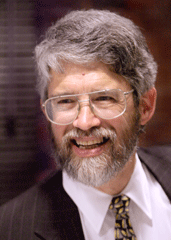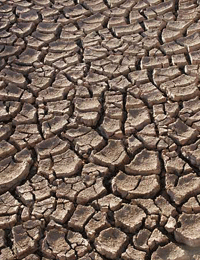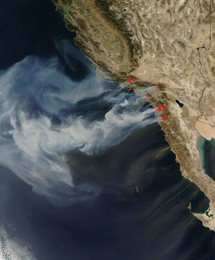Air Date: Week of June 19, 2009

Presidential science advisor John Holdren.
The Obama Administration just released a brutally honest report on the state of our climate. It spells out to everyone from lawmakers to lay-people that climate change is real and it is here now. President ObamaÂ’s top science advisor John Holdren tells host Steve Curwood that we need to address this challenge now.
Transcript
CURWOOD: From the Jennifer and Ted Stanley studios in Somerville, Massachusetts, this is Living on Earth. IÂ’m Steve Curwood.
YOUNG: And IÂ’m Jeff Young.
Back in 2007 it took a court order to get the Bush administration to follow a congressional mandate and issue a comprehensive report about climate change. But the Obama administration has embraced the opportunity enthusiastically.
Its 192-page report is called “The Global Climate Change Impacts in the United States.” It’s heavy on the science, but it lays out the challenges in dramatic, accessible language.
Thirteen government agencies collaborated on the effort, including the National Oceanic and Atmospheric Administration, which is headed by Jane Lubchenco.
LUBCHENKO: First and foremost, human induced climate change is a reality not only in remote polar regions and in small tropical islands, but every place around the country in our own backyards. Climate change is happening and itÂ’s happening now.
CURWOOD: Today the levels of heat-trapping gasses in the atmosphere are setting us on a course to make our planet hotter than itÂ’s been in 800,000 years.
And the new report warns that if we do nothing the average surface temperature of the planet will continue to get even hotter, by as much as eleven degrees Fahrenheit by the end of the century.
President ObamaÂ’s top science advisor, John Holdren, presented the report at the White House. Dr. Holdren is a noted climate expert who in this administration holds the same rank as the PresidentÂ’s National Security Advisor. In a far-ranging conversation, John Holdren was both cautious and upbeat about the future.
HOLDREN: Well I would say the report is clear - the climate is changing – that the impacts are already being felt. In that sense it is a stark report. And in the sense that the projections show all of these adverse impacts getting steadily worse over time, if climate change proceeds unabated, it’s a stark report. But it’s optimistic in the sense that it tells us that if we take appropriate actions to reduce the emissions of the heat trapping pollution that is the main driver of this problem, we can greatly reduce the amount of climate change and the damage from it that occur in the future. And the report is optimistic as well because it is showing the way to steps we can take to adapt to climate change in ways that will reduce the harm over time.
CURWOOD: If the world and the United States doesnÂ’t address climate change, can you give me a couple of examples where people will really notice this.
HOLDREN: Well first of all I would say weÂ’re already noticing it. People are noticing changes in the growing seasons. TheyÂ’re noticing the increased frequency of wildfires, the increased frequency of floods in the United States. So the place to start is that we really are already experiencing adverse effects of climate change. What we will see if climate change continues unabated is all of these kinds of symptoms that IÂ’ve described will become more severe. I would say that people in the West are likely to notice increasing difficulties with water shortages. In the longer run, one of the most noticeable effects is likely to be the increase in sea level that comes from a warming world and that weÂ’re already experiencing at a rate that is about twice the rate of sea level rise in the 20th century. You would have in some parts of the country where there might be ten or twenty days a year over 100 degrees Fahrenheit now, you would in the future with these large increases in average temperature, you might have 100 or 150 days a year that exceed what you might call the threshold of very, very hot that would have large impacts on agriculture.

Climate change will mean more droughts in the U.S. West, with some places likely to experience more than 100 days per year with temperatures higher than 100 degrees Fahrenheit.
HOLDREN: I mean the productivity of food crops would go down. You wouldnÂ’t be able to grow as much corn or wheat on an acre of land as you can grow today because the heat stress on the plants would be damaging their capacity to grow and bear grain.
CURWOOD: Some people say look, weÂ’re on this path, climate change is inevitable, weÂ’re in it now, itÂ’s simply gonna get worse and the sense comes up that it may just be too late to do anything. How accurate is that?
HOLDREN: I absolutely disagree that it’s too late to do anything. What the science shows above all is that the more climate change we get the more difficult it’s going to be to cope with it. And we have opportunities by acting now and in the future to drastically reduce the amount of climate change we’re gonna be experiencing. I mean this is a very simple proposition: more is worse, less is better. And we have the opportunity, by taking action, to make it less – that’s what we ought to be doing.
CURWOOD: What do we need to do?
HOLDREN: We need to be reducing the emissions of heat trapping pollution and above all thatÂ’s carbon dioxide from burning the fossil fuels from which we get most of our energy today, that is from burning coal and oil and natural gas. What we need to do is to use those fuels more efficiently so we donÂ’t have to burn so much of them to get the goods and services that we need from energy. What we need to do is change the technologies we use to burn them so that we can capture a substantial part of the carbon dioxide that would otherwise be released and sequester it away from the atmosphere. We need to use more renewable technologies which donÂ’t emit carbon dioxide or as in the case of sustainably grown biofuels, only emit as much carbon dioxide when theyÂ’re burned as they removed from the atmosphere when they were grown. We need to see if we can address the obstacles that have impeded the expansion of nuclear energy in this country and elsewhere because nuclear energy too is a way to get electricity that does not emit carbon dioxide into the atmosphere. And we need to take steps to slow down and halt deforestation and other land use practices that are adding carbon dioxide to the atmosphere along with the burning of fossil fuels.
CURWOOD: Tell me: what are our range of options here? YouÂ’ve outlined how difficult things will be if we do nothing. If we do everything, do we still get to avoid more warming here?
HOLDREN: There is nothing that we can to do stop climate change in its tracks. ThereÂ’s a tremendous amount of momentum built into the climate system. We are not yet experiencing the full consequences of the heat trapping gases weÂ’re already added to the atmosphere, because of time lags in the way the global system responds. So we will see some continuing increase in global surface temperature and regional increases in surface temperatures no matter what we do. But, we have a big opportunity to minimize the amount of change we will experience. The aim that most scientists who study this matter have agreed is one that is still within reach and is highly desirable, would be to stabilize the concentration of heat trapping gases in the atmosphere at a level that would limit the global average surface temperature increase to about three and a half degrees Fahrenheit above the pre-industrial level. Now, if we do everything right, I think we can achieve that. And to tell you what that means, you really have to look at this, first of all, at the global level, because it is the global concentration of these heat-trapping pollutants that determine how much the temperature goes up.
CURWOOD: Now, as I understand it, between the United States and China, there are about 40 percent of the worldÂ’s emissions of carbon right now. And I also understand that you were in China with the negotiating team on the Global Climate Change Treaty recently. What do we need China to do in order to have a reasonable agreement on limiting greenhouse gases for the world?
HOLDREN: Well first of all it is correct that China and the United States are the two largest emitters of greenhouse gases in the world, and we do total something in the range of 40 percent of global emissions. And that means that there is no way that the problem can be solved without doing both of us taking very significant actions to reduce our emissions. The United States and China are both already doing a number of things to reduce their emissions but we need to do much more. And it has to be expected because the United States is an advanced industrialized country and China remains a developing country, that the United States along with the other industrial nations is going to have to do more sooner – my personal judgment would be that the United States and the other industrialized nations should peak no later than 2015 and be sharply declining in their emissions after that. And that China and other developing countries need to peak between 2020 and 2025, and be sharply declining after that.
CURWOOD: Assess for me the odds of President Obama going to Copenhagen at the conclusion of the current round of international negotiations on climate change. Will he be there do you think?
HOLDREN: I simply cannot comment on that. I just donÂ’t know at this juncture. It will obviously depend on a whole array of issues in terms of whatÂ’s on the PresidentÂ’s plate at the time, and whether it appears that there would be a significant benefit from his going to Copenhagen. And I think itÂ’s much to early to predict how that will come out.

NASA's Terra satellite in 2007 captured an image of Southern California wildfires, expected to become more frequent as the planet warms up. (Courtesy of NASA)
HOLDREN: First of all, IÂ’m not sure that the President not going would mean that negotiations had failed. It might mean the negotiations had succeeded without him and he didnÂ’t need to go. He could simply celebrate the success from Washington. But the second thing I would say is we do need an agreement in Copenhagen. And weÂ’re working very hard with our various international partners to make sure that that happens. But the most important single thing the United States can do is to get its own house in order by passing a comprehensive energy climate bill and having that legislation in place because that will demonstrate that the United States is finally prepared to take the leadership role that the world expects of us in addressing this challenge.
CURWOOD: So, there you are in the Executive Office Building. YouÂ’re at the White House. If for a moment, the proverbial magic wand was put in your hand to do anything about this, what would be the first thing you would do.
HOLDREN: The first thing I would do is get enough votes in the House and in the Senate to pass a comprehensive energy and climate bill.
CURWOOD: The second thing?
HOLDREN: The second thing I would do is advise the President to sign it.
CURWOOD: And the third thing?
HOLDREN: The third thing I would do is work with industry, government, NGOs, universities and so on to generate the degree of innovation in energy technology that will enable us to meet those targets in the most cost effective possible way.
CURWOOD: As science advisor, whatÂ’s the one thing that youÂ’d love to do that you just canÂ’t do?
HOLDREN: Take vacations.
[LAUGHING]
CURWOOD: The climateÂ’s not waiting is it?
HOLDREN: [laughing] The climate is not waiting.
CURWOOD: John Holdren is President ObamaÂ’s science advisor. Thank you so much.
HOLDREN: My pleasure. Glad to be with you.
YOUNG: Coming up: the few, the proud, the poisoned-- Marine veterans still living with a legacy of contamination. Keep listening to Living on Earth.
Links
**WEB EXTRA** Listen to all of Living on Earth's interview with John Holdren.
Check out a 2002 Living on Earth interview with John Holdren here.
Click here to learn about progress on international negotiations on climate change here.
Living on Earth wants to hear from you!
Living on Earth
62 Calef Highway, Suite 212
Lee, NH 03861
Telephone: 617-287-4121
E-mail: comments@loe.org
Newsletter [Click here]
Donate to Living on Earth!
Living on Earth is an independent media program and relies entirely on contributions from listeners and institutions supporting public service. Please donate now to preserve an independent environmental voice.
NewsletterLiving on Earth offers a weekly delivery of the show's rundown to your mailbox. Sign up for our newsletter today!
 Sailors For The Sea: Be the change you want to sea.
Sailors For The Sea: Be the change you want to sea.
 The Grantham Foundation for the Protection of the Environment: Committed to protecting and improving the health of the global environment.
The Grantham Foundation for the Protection of the Environment: Committed to protecting and improving the health of the global environment.
 Contribute to Living on Earth and receive, as our gift to you, an archival print of one of Mark Seth Lender's extraordinary wildlife photographs. Follow the link to see Mark's current collection of photographs.
Contribute to Living on Earth and receive, as our gift to you, an archival print of one of Mark Seth Lender's extraordinary wildlife photographs. Follow the link to see Mark's current collection of photographs.
 Buy a signed copy of Mark Seth Lender's book Smeagull the Seagull & support Living on Earth
Buy a signed copy of Mark Seth Lender's book Smeagull the Seagull & support Living on Earth

